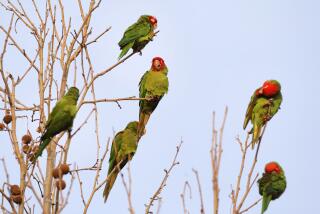On the Prowl for Bats : The creatures’ popularity is taking flight. Fans hang wooden houses to lure them close to home.
- Share via
Bats are our friends. Really. With Halloween on its way, this might not be the time of year to convince people of the value of these odd-looking mammals, but the truth is, bats have a role to play in the universe.
In fact, more and more people are finding bats so fascinating that they are trying to attract them to their neighborhoods by hanging wooden bat houses on their property. Others are trying to locate the creatures by buying $250 ultrasound bat detectors, while fellow enthusiasts support bat-based research by joining the 12,000-member Bat Conservation International Inc. (BCI), based in Austin, Tex.
The flying mammals are particularly interesting to children, who are often attracted to bats because of their mysterious-looking bodies and nocturnal lifestyle, says Bill Kennerly, a BCI member from Winnetka.
Parents, however, might be put off by the time-honored association of bats with blood and disease. While prevailing fears are likely to be exaggerated, George Phipps, chief veterinarian for the city of Los Angeles, warns against picking up and handling any wild animal, especially bats, which may indeed carry rabies.
The thrill of danger does, of course, contribute to the allure of the small, winged creatures. Recalling his own childhood bat fixation, Kennerly says, “The fascination was more morbid because of their association with vampires and Dracula and all that.”
For Kennerly, a graduate student in music at Cal State Northridge, the thrill never has worn off. Recently, he bought a book on how to build a bat house, a wooden, vented, mailbox-sized box designed to attract homeless bats and provide roosting chambers and places for nursery colonies. He plans to construct the house soon--after he talks to his neighbors about the benefits of having bats on the block.
According to BCI, these benefits are considerable. Bats are the major predators of night-flying insects: A single brown bat can eat 600 mosquitoes an hour. Bats also pollinate flowers and disperse seeds. And BCI members say they are fun to watch.
Veteran bat watcher Suzanne McPhee first discovered this when a group of brown bat babies showed up under the eaves of an old stable where she used to ride. McPhee helped a friend care for the newborns and fell in love with them.
McPhee, who has just hung up a bat house at her Northridge condominium, believes that bats offer children a terrific opportunity to learn how to study the biological world and to understand something about ecosystems, migration, hibernation and endangered species.
According to McPhee, brown bats and Mexican free-tailed bats can be widely seen in the San Fernando and surrounding valleys, especially under street lights--where they come to feed on insects--under eaves and near ponds and lakes.
McPhee encourages families to learn more about bats so they can help protect them. BCI says bats are among the world’s least appreciated and most endangered animals, and the primary cause of their decline is destruction by humans acting out of fear or ignorance.
“Bats are needless victims of human misunderstanding,” says McPhee, who is a pilot with Med West Inc. in Canoga Park. “And they’re fun.”
WHERE AND WHEN
What: Bat Conservation International Inc.
Membership: $30, which includes a quarterly magazine, Bats, a catalogue of educational materials and participation in member field trips and workshops.
Write or Call: P.O. Box 162603, Austin, TX 78716, or call (512) 327-9721.
More to Read
Sign up for The Wild
We’ll help you find the best places to hike, bike and run, as well as the perfect silent spots for meditation and yoga.
You may occasionally receive promotional content from the Los Angeles Times.






